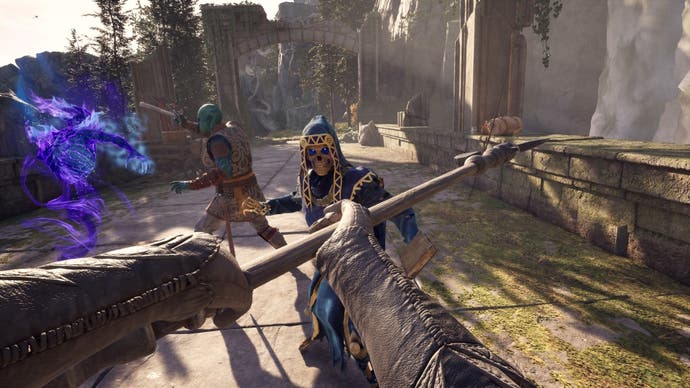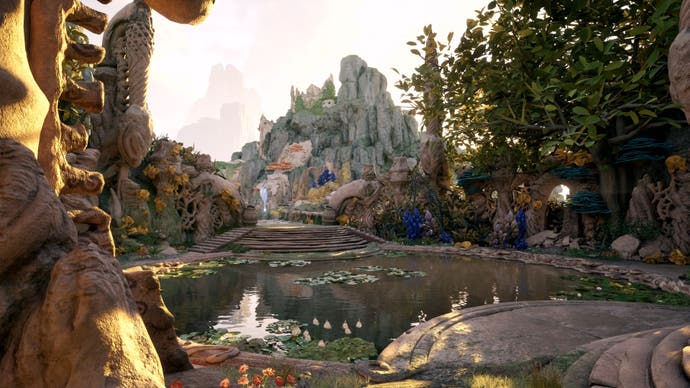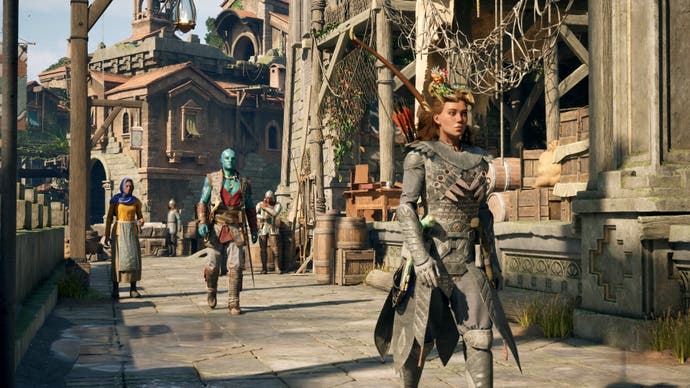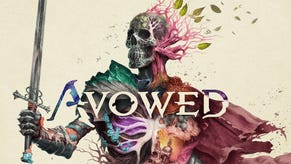After three hours, Avowed still shows no sign of a killer hook to call its own, but this fizzy RPG cocktail is plenty enjoyable all the same
A clear step up from The Outer Worlds.
Avowed is a bizarrely elusive prospect. Obsidian’s latest fantasy RPG was initially suspected to be its equivalent of Skyrim, but this is a description the studio has repeatedly refuted. It takes place in the same universe as the Pillars of Eternity games, but its glossy, modern package seemingly runs counter to the heritage of that series. Unlike Obsidian’s other recent games, such as the diminutive survival game Grounded or the medieval murder mystery Pentiment, it has no clear defining quality beyond its genre and who is making it (which some might argue is enough).
Having now played Avowed for several hours, I better understand why it’s been such a difficult game to communicate. This is a fantasy RPG that, rather than having one, easily identifiable hook, seeds numerous smaller ideas into the genre’s mechanical archetypes. It’s a game that moves a little like Mirror's Edge, fights a bit like Dishonored, talks a bit like Mass Effect, and looms a bit like Skyrim. Yet taken as a whole, it isn’t directly comparable to any of these games, binding these elements together with the rich worldbuilding and intricate dialogue systems Obsidian is known for.
The premise, at least, is easy enough to grasp. Set in Pillars of Eternity’s world of Eora, Avowed sees you play the Emperor of Aedyr’s personal envoy to The Living Lands. An untamed island wilderness on the far side of the world from Pillars of Eternity 2’s Deadfire Archipelago, The Living Lands is inhabited by pirates, imperial dissidents, and the remnants of frustrated colonial expeditions. You’re dispatched specifically to investigate the dreamscourge, a strange, emerging epidemic that is spreading across the island.
After a brief tour of the character creator, which among other things let me assume they/them pronouns and stick giant mushrooms to my face, my Envoy was swiftly shipwrecked upon an offshore islet close to The Living Lands. Dusting myself off, I join up with a small, furry blue fellow called Garryck, who looks a bit like he hatched from a surprise toy. Together, we climb up to an abandoned fort in search of a means of escape.
This brisk tutorial section introduces the fundamentals of Avowed’s open-class roleplaying systems, which includes melee and ranged combat, a highly physical magic system, and light stealth. We’ll delve into the nuances of these later, but the most immediate impression Avowed makes is through its movement. Avowed is extremely light on its feet, with your Envoy leaping, mantling and sliding past obstacles in a manner that makes traversal extremely fluid, and livens up moment-to-moment exploration.

After climbing up to the fort, fighting a few lizard-like Xaurips, and liberating an aggressive Scottish lady called Ilora from a prison cell she’s been locked in, we escape the islet via a rowboat to arrive in Dawnshore, Avowed’s first proper zone. Similar to The Outer Worlds, The Living Lands is split up into separate areas you can travel between, rather than being a seamless open world.
It’s worth pointing out this wasn’t always the case. “There was a much earlier idea of trying a seamless open world” says Carrie Patel, Avowed’s game director. “When I joined the project in January 2021, we did a creative pivot, and one of the decisions that went with that was going to a series of open zones.” Patel says the reason for this was partly technical, but it was also made because it allowed Obsidian “to create this very distinct sense of separate regions with very different biomes.”
While I’m not convinced this reasoning flies - there are plenty of open world games that also feature distinctive biomes - the argument is somewhat moot, because seamless or not, Dawnshore feels sufficiently open. A great oval of lush grassy plains and verdant forests, Dawnshore is fringed by mountains to the north and coastal cliffs to the west. At the centre of the region is a vast, ancient city, its formidable walls a constant presence as you explore the surrounding countryside.
Yet while the land of Dawnshore is plenty green, pleasant is another matter. Across the region, there is a sense that nature is simply Not Having It with this civilisation nonsense. The timber-built harbour town where you arrive in Dawnshore appears to be mouldering in real time, while away to the north is a village-sized thicket of thorns called the Strangleroot.



There are also mushrooms everywhere. Now, mushrooms are commonly used as shorthand for "weird" in fantasy games, and from a visual perspective at least, I question whether Avowed’s implementation of them is as distinctive as the developers believe. That said, there’s also more to Avowed’s abundant fungi than kooky set dressing. “[It] expresses the invading dreamscourge, and that is tied to the metaphysics of the world,” says region designer Berto Ritger. “You're sent to Living Lands to investigate that soul plague, the dreamscourge. So we want that visual to be tied as well to the themes of the narrative.”
Inconveniently, it’s somewhere within the Strangleroot where the Ambassador to The Living Lands, the person our Envoy was supposed to rendezvous with upon arrival, has gone missing. Luckily, a local Aumaua (semiaquatic humanoids with iridescent skin) named Kai has business in that area, and agrees to help us find him.
Kai is the first proper NPC companion you recruit in The Living Lands, voiced by Brandon Keener (aka Mass Effect’s Garrus). Perhaps because of this, Kai quickly establishes himself as an excellent hang, a winningly earnest, gently affable insta-pal who can crack a joke without relying on them in lieu of a personality. You could argue that parachuting Garrus into your RPG is a cheap way to win players over, but aside from being slightly unfair to Kai as his own character, it does also work.

More broadly, Avowed’s writing is more grounded compared to the relentless zaniness of The Outer Worlds, which I personally found more to my taste. This isn’t to say Avowed is deadly serious - Obsidian’s trademark humour still raises its head - just that there’s a more natural register to dialogue, less pressure to be quippy and quirky. In addition, as you’d expect from an Obsidian game, there are plenty of dialogue choices to pick from in any given conversation. It’s hard to judge exactly how responsive Avowed’s narrative will be from a couple of hours play, but many NPCs I encountered actively commented on my Envoy’s facial fungus, which is a promising start.
As I venture beyond the harbourside with Kai, I’m struck by how much of a constant presence he is, remarking on landmarks we pass like an abandoned lighthouse outside of town, getting stuck in during combat, and generally feeling like a fellow traveller, rather than trailing quietly behind you, sworn to carry your burdens. “We want [companions] to feel really present in the story,” says senior narrative designer Kate Dollarhyde. “And in order to do that, we take into consideration where they're appearing on screen in conversation, how much they're commenting on the world around them, how much they pipe up in conversation with NPCs, and then them coming to you at party camp to talk about the stuff that you've experienced.”
I decide to check out the lighthouse Kai points out, putting the parkour-like movement through its paces before leaping gleefully from the top into the sea below. In this and the broader environment, Avowed’s landscapes are more rugged and naturally sculpted than those seen in The Outer Worlds, the environment dotted with landmarks at varying heights that draw you in and utilise the game’s sleek first-person platforming. “One of the things that we really wanted to evolve with Avowed over The Outer Worlds is that sense of verticality of space,” says art director Matt Hansen. “It's a hell of a lot harder to do that, but we were standing on the shoulders of giants. The Outer Worlds figured out a lot for us, and New Vegas figured out a lot before that.”

"One of the things that we really wanted to evolve with Avowed over The Outer Worlds is that sense of verticality."
After exploring some caves beneath the lighthouse and raiding a treasure chest stashed there, I start heading toward the Strangleroot. But it isn’t long before I’m pulled aside by a quest to help a woman whose house has been taken over by xaurips. This means passing through an area patrolled heavily by the little lizardmen, which in turn means it’s time to fight.
Combat is perhaps the most heavily debated part of Avowed, thanks to an underwhelming showing in a trailer from earlier this year. I was likewise sceptical of the fighting Obsidian had showed thus far, but the combat I experienced first-hand was fun, satisfying, and had a distinctive flair. Your character is as fleet-footed during fights as they are in general play, nimbly sidestepping enemy attacks, and lunging at foes with powerful strikes that can break through their guards. Even your basic starting dagger has real momentum behind its thrust, while larger weapons have greater heft at the cost of some manoeuvrability. It’s a little stickier than I would like, with strikes locking you into a specific enemy for a split-second before you can withdraw.
“We really took it very seriously,” says gameplay director Gabe Paramo. “Took it as a sense of urgency that, okay, this is something that players are not happy with and we really want to jump on that immediately.” Since then, Paramo says the team has worked on “that sense of hitting, that feedback of hit reactions, the delay between the hit and the reaction actually happening, really looking into that kind of a more frame-by-frame step-through.”

Alongside this added physicality, there’s a fair amount of range to the combat system. You’re able to dual-wield pretty much any combination of one-handed weapons, while ranged weapons like bows and arquebuses let you target enemy weakspots by aiming. You also unlock more specific combat abilities as you level up, which can be mixed and matched between the three broad class archetypes of warrior, ranger, and mage. The character I played in the preview was mostly magic focused, thwip-thwip-ing enemies from a distance with a wand. But I also unlocked the fighter’s “Charge” ability, which let me body any enemy that closed in for a melee attack, knocking them over in a pile of ragdoll limbs.
On the subject of magic, one of Avowed’s most interesting features is its grimoires. These equippable spellbooks contain an array of incantations which can be quickly deployed during a fight, like a blizzard of ice bolts that freeze enemies in place, or a lightning attack that can electrify a pool of standing water. There are shades of Bioshock to how they function, although grimoires are entirely optional, and combat is more stat-driven than Irrational’s game.
This isn’t the only area where Avowed dips a toe into the immersive sim genre. After reaching the house infested by xaurips, I deal with the external guard and have a wander around the building. Sure enough, there’s a way to sneak into the back, and I manage to dispatch a couple of the xaurips using a special stealth kill ability before the lizards notice my presence. I ask the developers how extensive Avowed’s stealth systems are. They explain that you’ll be able to use it to skip parts of a dungeon or encounter, but you won’t be able to ghost the entire game. “It's the same thing as a conversation. You can have conversation choices that skip combat based off what you've put your stats into,” Paramo says. “Not every single encounter will supply that, but there will be a variety of encounters that have those options.”

The more I played of Avowed, the more it felt like “variety” was the game’s operative word. After a couple of hours, I’d unlocked a fairly extensive arsenal of weapons and magic abilities, all of which were enjoyable to experiment with, and felt like viable play paths. There’s a pleasing flow between different play states, too. You’ll scramble up the wall of a building to enter it via a hole in the rooftop, have a flashy little fight with whatever’s inside, raid the loot chests and snatch the quest item you were after, then dash back to town and roll into a slick dialogue sequence, Kai chiming in as you talk.
Are there concerns? Sure. While combat was fun, it was also undeniably on the easy side, and I beat the (admittedly early) boss guarding the interior of the Strangleroot without breaking a sweat. And as I mentioned earlier, I worry that The Living Lands might not be as strange to players as Obsidian believes it to be, especially with games like Elden Ring and Baldur’s Gate 3 offering some serious weirdness within their own fantasy frameworks. Again though, I’ve only seen a glimpse of the larger world, and the Pillars games were themselves stranger experiences than they initially appeared.
Finally, there is still that absence of an easily grasped hook. Avowed does a lot of things that I like, and I enjoyed my time with it, more than I ever enjoyed The Outer Worlds. That said, nothing I saw stood out as wildly original, or that Avowed could entirely call its own. That isn’t to say such an element doesn’t exist, or even that Avowed necessarily needs it. But for better or worse, there is still some mystery at the heart of Avowed. The question for when it launches is: will there be a solution?










